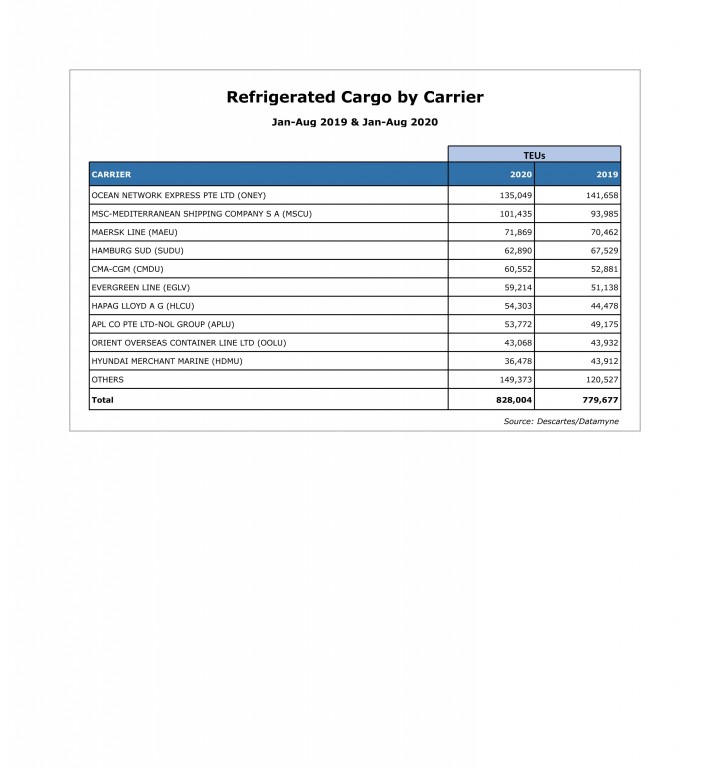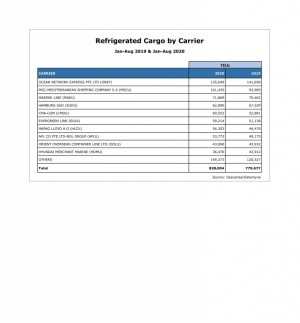In 2019, the August through November apple harvest in Washington State yielded a record 133.9 million 40 pound boxes of fruit. Yet fewer apple exports have crossed the docks of the ports of Seattle and Tacoma since the COVID-19 pandemic began. Washington usually exports around 30% of its apple production to 60-plus countries around the world.
As with many changes to the trade environment this year, the virus is thought to be responsible. “The feedback we’ve received is that there has been an increase in domestic demand,” said Georgette Reidburn, business development manager at the Northwest Seaport Alliance (NWSA), which includes both ports. “More people are eating lunch at home and not going out for dinner, so instead of the apples going out internationally, there has been increased local consumption.”

Since more people are eating more meals at home, they are also willing to and interested in expanding their gustatory horizons by eating a greater variety of fresh fruit. Eric Casey, CEO of GT USA Wilmington, a unit of Gulftainer that has been running the Port of Wilmington since 2018, has noticed growth opportunities for imports of new varieties of fruit as the pandemic proceeds, and in its aftermath.
“We expect growth in the switch to specialized grapes,” said Casey. “Most Americans are familiar with Thompson seedless table grapes. Now we are seeing different varieties and different flavors from Chile and elsewhere starting to garner interest from American consumers. They are opening their taste buds and are becoming more experimental.”
One such newer grape varietal is called Cotton Candy, which was developed in Bakersfield, California, in 2011. The Cotton Candy grape, which has 12% more sugar than a regular table grape, is a hybrid of Vitis vinifera, the most common grape species in the country, and a Concord-like grape (first cultivated in Concord, Massachusetts by Ephraim Bull).
“Newer varietals of grapes are becoming more mainstream,” said Casey. “The pandemic may have opened opportunities for people to try new things as are they are eating more from home and don’t want to have the same food. They are eating less in restaurants, so they want to try new and interesting things at home.”
Banana Volumes Down
On the other hand, banana imports in Wilmington shrank since COVID arrived. The likely reason, according to Casey: bananas are popular in kids’ lunchboxes, but, since fewer are going to school, parents have eased up on banana buying. Beyond these anomalies, Casey says “perishables have been relatively stable compared to other goods during the pandemic.”
At the Port of Philadelphia, container volumes through the Packer Avenue Marine Terminal are up 5% this year, largely on the strength of increased perishables volume. “We are on track to record double-digit growth in refrigerated cargo volume for 2020,” said Leo Holt, president of Holt Logistics, which operates the terminal. “Consumer demand for fresh fruits and vegetables remains at an all-time high.” The International Association of Refrigerated Warehouse (IARW) recently named Holt Logistics Corp. the 13th largest refrigerated warehousing and logistics provider in North America.
The pandemic has also driven seaports with perishables capacity to the forefront of food distribution in areas experiencing food scarcities due to the COVID-19 pandemic. At the Port of Hueneme, in California, the port, along with Del Monte Fresh Produce, hosted 20 food distributions across Ventura County. These efforts have provided over 10,000 families with bananas, strawberries, and produce.
“Our work does not stop at the docks,” said Jess Ramirez, the Oxnard Harbor District President.
Del Monte Fresh Produce, together with Holt Logistics, has also made food donations in the Philadelphia and southern New Jersey areas.

Investment in Perishable Infrastructure
As the perishables trades continue to increase in importance, ports invest in the infrastructure required to handle and store them. One key such infrastructure investment in NWSA is at Terminal 5 in Seattle. The investments include 1,500 new reefer plugs and will allow the facility to handle ultra-large container ships with a capacity of up to 18,000 TEU.
“We are just finishing stabilizing the pier and we will be bringing in postpanamax cranes,” said Reidburn. “We are working with carriers to encourage them to bring in more imports of reefer cargo.”
Construction work at Terminal 5 began in early 2019, and has an expected completion date of early 2023. The port region has also seen recent private investments in cold storage in the vicinity of the ports, according to Reidburn.
Since Gulftainer took over operations at the Port of Wilmington under a 50-year concession two years ago, its investments have increased available space for refrigerated goods handling by 200,000 square feet to a total of one-million square feet. Container stacks have also been added to as have over 400 new refrigerator plugs.
“We continue to expand those capabilities while making use of our current footprint at the port,” said Casey. “We did not stop the yard densification program during the pandemic. The construction work continued.”
Meanwhile, Momentum Logistics, a sister company of GT USA Wilmington, began operations at the port in the last few months, providing dray services for both refrigerated and dry goods. “They transport produce out of Wilmington,” said Casey, “to distribution centers and retail centers as appropriate.”
Warehouse space for refrigerated cargoes is also increasing in Wilmington. “We are in negotiations with a customer right now,” said Casey, “for new warehousing and new racking to meet increased demand and for new cooling technologies to provide better cooling. We want to handle different types of produce and to provide special types of handling.”
Casey sees plenty of growth possibilities for the future, “especially in bringing in fruit and produce from new countries such as Chile.” “We are bullish on perishables,” he added. “We are seeing growth across the board.”







